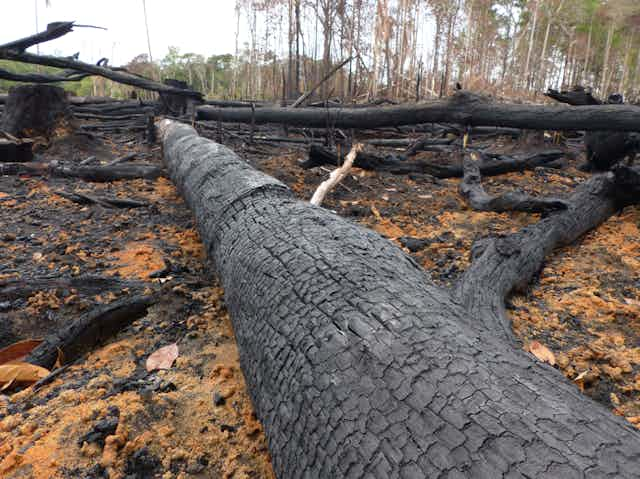The Amazon is under threat from all sides. Over recent weeks, unprecedented blazes have spread through an ecosystem not adapted to fire. Much has been made of the consequences of these fires for global heating – but at a local level, the effects could be even more severe.
While it’s too soon to establish the cause of the Amazon fires with certainty, levels of burning and deforestation are closely linked. Cut vegetation is routinely set alight to create cattle ranches and support land claims, in some cases sparking uncontrolled wildfires.
Read more: Amazon fires explained: what are they, why are they so damaging, and how can we stop them?
After reaching a record low in 2012, deforestation in the Brazilian Amazon has been rising steadily, and has surged since Jair Bolsonaro became president in January. Recent data shows deforestation from January to August this year was the highest it’s been for a decade, increasing by 75% relative to the same period in 2018. That fires have also not been this extensive for a decade is surely no coincidence.
With its vast store of carbon locked up in trees and soils, the Amazon – and its health – is of huge importance for global heating. There are concerns that emissions from the recent fires could hinder attempts to reach the climate targets set by the Paris Agreement.
But the Amazon is also vital to local communities who depend on its fertile land. Many indigenous peoples have seen their territories invaded and deliberately burned in recent months, jeopardising lives and livelihoods.

In this context, there is a pressing need to understand the benefits that intact Amazon forests provide to local populations, in addition to their importance at a global scale. Whilst scientists have been monitoring the global impacts of deforestation and fires for decades, how the Amazon regulates the local climate has not been widely studied.
Local heating
In a new study, my colleague Dominick Spracklen and I investigated how deforestation influences the local Amazonian climate.
We selected areas of intact forest – regions of woodland that haven’t been affected by human disturbance – using the Intact Forest Landscapes maps. These undisturbed forests have lost less than 5% of their canopy cover, confirming their relative stability. We also identified forests that had lost their intact classification because of human disturbance, such as logging and fire.
Using satellite data, we examined climatic changes, particularly in temperature and rainfall, over these large swathes of forest between 2001 and 2013. While local-level rainfall was unaffected, we found that intact forests transfer more water to the atmosphere through a process known as evapotranspiration than areas that have been deforested. Evapotranspiration can be thought of as the forest sweating – as water evaporates from the leaves and the ground it cools the environment.
Less evapotranspiration reduces the cooling capacity of forests and causes local temperatures to rise. While global warming continues to affect all regions of the forest, disturbed forests saw much stronger local warming, with annual temperatures rising by 0.44°C more than neighbouring intact forests over the study period. This may not sound like much, but it equates to approximately half of the warming seen in the region over the last 60 years.

The effects of deforestation were most pronounced during the dry season, when temperature differences of up to 1.5°C were observed between intact and disturbed forests. This is because water is only available from deep in the soil during the dryer months, inaccessible to the shorter-rooted pasture vegetation that grows once forest has been felled.
Accelerated climate breakdown
Higher temperatures increase the likelihood and intensity of drought during the dry season, as they increase plant demand for moisture at a time when water is already scarce. Increasing temperatures and drought are already shifting the plant composition of the Amazon, and many trees will perish as conditions breach the limits at which they can survive.
Droughts also severely reduce populations of fish, waterfowl and dolphins, and make life increasingly difficult for local people who depend on small-scale agriculture for survival.
Read more: Amazon fires: eight ways you can help stop the rainforest burning
Forests also become more susceptible to fires, which in already drier areas can cause almost all of the remaining trees to die. At this point, rainforests become nothing more than low diversity and low carbon ecosystems with a fraction of their current social, ecological and climatic value.
Worse still, evidence suggests that between 3°C and 4°C of warming will be a tipping point for the Amazon, beyond which large parts of the rainforest may switch to a savanna-like state with much poorer capacity to store carbon and support wildlife. Given that we have already reached more than 1°C of warming globally, an extra warming of 1.5°C in the dry season poses a serious threat to the continued existence of these degraded rainforests.
Intact tropical forests are crucially important, not just for global heating, but for the local climate too. In his haste to economise the Amazon, Bolsonaro would do well to remember that.


